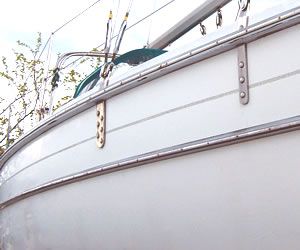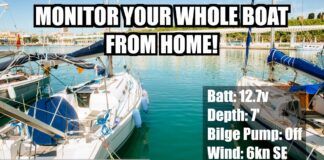Photo by David Leo

The primary components of the Com-Pac 35 are the hull, a pan that provides housing for cabinetry and the motor mount, a headliner, and the deck.
The hull construction begins with the application of a coat of Neste gelcoat. The skin coat is a layer of 1.5-ounce mat bonded with Riechold Hydrex vinylester resin to prevent osmotic blistering.
The layup at the keel consists of multiple layers of 17-ounce knitted fabric that produce a half-inch thickness of solid fiberglass. Outboard of the keel, the layup consists of layers of 3/4-ounce mat. One layer of 3/4-ounce mat is laid up around the sheer line to provide additional stiffening. Additional layers of 17-ounce fabric are laid up at the chainplate attachment points.
Topsides are cored with a thin layer of Coremat.
The bottom of the hull also is coated with epoxy. With vinylester resins in the layup and the additional barrier coat, this method should prevent blistering.
The headliner is a solid fiberglass section that is part of the hull-deck structure, Gerry Hutchins explained. Its constructed of two layers of 1.5-ounce mat and 24-ounce woven roving, bonded to the hull with knitted fiberglass.
The deck is hand-laid with a skin coat of 1.5-ounce mat reinforced in high-load areas with 17-ounce knitted fabric. Its cored with 3/8-inch Klegecell, over which are laid layers of 1.5-ounce mat and 24-ounce roving.
The hull-deck joint is fairly conventional and should not leak. It consists of an outward flange on the hull onto which the deck is laid. The joint is secured with Bostitch 920 urethane sealant and No. 10 machine screws and nuts on 4-inch centers. This joint is also bonded on the inside of the hull with knitted fabric.
Most deck hardware is mounted in drilled holes and secured with backing plates. Winches are attached to plywood backing built into the coaming.




































